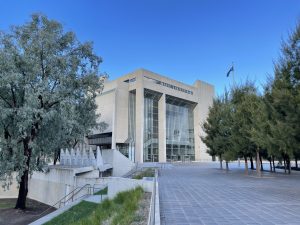 Jeremy Patrick is a Lecturer for the University of Southern Queensland School of Law and Justice
Jeremy Patrick is a Lecturer for the University of Southern Queensland School of Law and Justice
In recent decades, the High Court of Australia has come under a steady stream of criticism for failing to reflect the multicultural diversity within Australian society [1]. Although some progress has been made in the area of gender equality and sexual orientation [2], the High Court remains notoriously homogenous in other respects like race, education, and professional background. The situation that Eddy Neumann described in 1973 has changed, but not as much one might hope:
[The] typical High Court Justice is a male white Protestant raised in Sydney or Melbourne (or much less frequently, Brisbane) and of British ethnic origins. He is from upper middle rather than upper class background, though perhaps more than his American counterparts from lower middle class environment. He usually goes to a high status high school (usually private) and then to Sydney or Melbourne university where he has a brilliant academic record. If from a moneyed family he immediately goes to the Bar [3].
This pattern of near-uniformity persists when it comes to religion. Although an exact breakdown by religious affiliation is unavailable [4], it’s incontestable that the vast majority of High Court Justices today and throughout Australian history have been members of mainstream Christian denominations. Indeed, the High Court’s poor record on religious diversity is perhaps exceeded only by its poor record on racial diversity.
The High Court’s religious homogeneity stands in stark contrast to the pluralism of Australian society. In the most recent census data from 2016, only 52% of Australians self-identified as Christian [5]. The fastest growing “religious” group are the Nones (30%)—individuals who report no religious affiliation [6]. One study notes that “there are now more Muslims (2.6%) than Presbyterians (2.3%). There are more Buddhists (2.4%) and Hindus (1.9%) than Baptists (1.5%) or Lutherans (0.7%), and more Sikhs (0.5%) than Jews (0.4%)” [7]. Suffice it to say that the appointment of a Presbyterian or a Baptist to the High Court would be unremarkable, but the appointment of the first Muslim or Buddhist would be ground-breaking.

A natural response to this observed discrepancy might be: why does it matter? If judges are simply applying the law to facts (calling balls and strikes like a baseball umpire [8] or applying a “strict and complete legalism” [9]), why would the religious identity of the judge matter at all? The answer, of course, is that legal judgments aren’t simply the product of a judge “finding the law” and then, with irresistible syllogistic logic announcing the outcome in light of the facts. The American legal realists of the 1920s and 1930s argued that this was descriptively false, and extensive empirical research in recent decades confirms that the personal values of judges are strongly correlated to the decisions they reach [10]. Just as much as race, class, and gender may impact one’s experiences and resulting worldview, a judge’s religious identity is likely central to the values they hold dear. And when a court lacks religious diversity, its members are only able to perceive the world through a narrow range of lenses [11].
None of this means that the High Court—or even the judiciary as a whole—could ever be expected to exactly match the demographic composition of the Australian public. Nor should we conceive any individual as a “representative” of the portion of the public whose characteristics they hold in common [12], or that the goal of finding meritorious individuals should be wholly displaced by a cynical quest to tick demographic boxes. But what we can expect and strive for is the principle that the courts will be a “fair reflection” of the society they help govern [13]. And to achieve this, those responsible for nominating High Court Justices must cast the net widely, look beyond the traditional markers of what makes someone “qualified” to sit on the court [14], and remember that a diversity of worldview—religion or belief included—is in itself a positive good that contributes to public regard for the Court and the soundness of the decisions it reaches.
[1] See, e.g., the excellent discussion in Elizabeth Handsley & Andrew Lynch, ‘Transparency and the Reform of Commonwealth Judicial Appointments 2008-2013’ (2015) 37:2 Sydney Law Review 187.
[2] See KCasey McLoughlin, ‘The Politics of Gender Diversity on the High Court of Australia’ (2015) 40:3 Alternative Law Journal 166.
[3] Eddy Neumann, The High Court of Australia: A Collective Portrait, 1903-1972 (Lawbook, 2nd ed., 1973) 105-06 quoted in Harry Hobbs, ‘Finding a Fair Reflection on the High Court of Australia’ (2015) 40:1 Alternative Law Journal 13, 13.
[4] Because only limited information is released publicly about individuals appointed to the High Court, demographic information is “both sparse and patchy.” Rachel Cahill-O’Callaghan & Heather Roberts, ‘Hidden Depths: Diversity, Difference and the High Court of Australia’ (2021) 17:2 International Journal of Law in Context 1, 2. Some data can be gleaned through CVs, press releases, and biographies, but there is no single, complete, publicly available set of demographic data on High Court Justices. Ibid. And unlike the extensive journalistic probing and public confirmation hearings for American nominees to the Supreme Court, appointment to the High Court of Australia is essentially a “tap on the shoulder” by the Prime Minister acting on the advice of Cabinet. See ibid. at 2.
[5] Gary D. Bouma and Anna Halafoff, ‘Australia’s Changing Religious Profile—Rising Nones and Pentecostals, Declining British Protestants in Superdiversity: Views from the 2016 Census’ (2017) 30:2 Journal for the Academic Study of Religion 129, 131.
[6] See ibid. The presence of so many Nones in Australia presents difficulty in evaluating the religious diversity of the judiciary. It’s possible some members of the High Court, for example, could be atheists, agnostics, or “spiritual but not religious” but have simply kept their beliefs private because of the cultural predominance of Christianity.
[7] Ibid at 132-33.
[8] Cf. John Roberts, Jr., ‘Opening Statement to Confirmation Hearing on the Nomination of John G. Roberts, Jr. to be Chief Justice of the United States,’ Hearings before the Committee on the Judiciary, United States Senate, 109th Congress (U.S. Government Printing Office, 2005) at 55-56 (“Judges are like umpires. Umpires don’t make the rules, they apply them. The role of an umpire and a judge is critical. They make sure everybody plays by the rules, but it is a limited role.”).
[9] Owen Dixon, ‘Address upon taking the oath of office in Sydney as Chief Justice of the High Court of Australia on 21st April’ (1952) 85 CLR xi.
[10] See the discussion and sources cited in Rachel J. Cahill-O’Callaghan, ‘The Influence of Personal Values on Legal Judgments’ (2013) 40:4 Journal of Law and Society 596.
[11] In the Australian constitutional context, for example, we might as a counterfactual imagine how the DOGS Case would be decided if, like Australia today, half the court were non-Christian, or whether, in the Stolen Generations Case, if the presence of an Aboriginal High Court Justice would change the way the Court responded to the freedom of religion claim concerning the suppression of Indigenous spirituality.
[12] See Hobbs, above n. 1, at 13.
[13] See ibid. at 13, discussing emergent international law standards of judicial independence and the principle of fair reflection.
[14] A Group of 8 education, successful private practice for a prestigious law firm, adherence to establishment values, etc.
